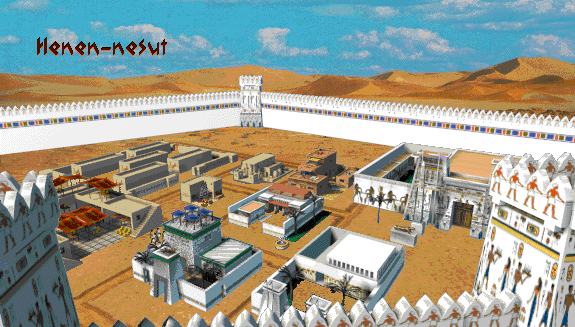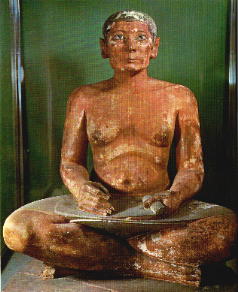

Our ram-headed god Herishef has His main temple here. His name means "He who is on his lake"; the Greeks call him Harsaphes. Somehow the Greeks also got the idea that Herishef was another name for Herakles, so the town acquired its classical name of Herakleopolis Magna.
The earliest part of Herishef's temple dates to the XIIth dynasty. The XVIIIth dynasty pharaohs enlarged it, because they viewed Herishef as an aspect of Horus and Amen, two of their favorite gods. Ramses the Great launched a major rebuilding program, and the temple is still in use today. Unfortunately I won't be able to take you in there, as the "House of the God" is not open to casual visitors; only the god-servants (priests) may enter. However, there are other holy places you may visit when our tour is finished: the shrine of PaTeri Amenemheb and the infamous Temple of Relief.
Southeast of the temple of Herishef is another temple built by Ramses II, at Kom el-'Aqarib.
Upstream from here is Dishasha, a village whose main point of interest is its late Old Kingdom tombs. Many of the 20th nome's officials are buried there. One of them, the rock-cut tomb of Inti, has been opened; it contains a rare scene of soldiers besieging a fortified town.
Heracleopolis was the main city of Egypt during a turbulent time in our history, the First Intermediate Period. Details are not clear, but apparently when the VIth dynasty ended, the rulers who followed were too weak to rule the whole land. Akhtoy, the local nomarch, declared independence from Memphis, and when the last Memphite pharaoh died childless, he declared himself god-king of the Two Lands and founder of the IXth dynasty. All of Middle Egypt and part of the eastern Nile Delta submitted to Akhtoy's authority. Akhmin, in the 9th nome, became the southern boundary between those who supported Akhtoy and those who opposed him.
In Upper Egypt there were at least three governors who refused to acknowledge the new order: those of Thinis, Wast (Thebes) and Nekhen (Hierakonopolis). For a long time they fought among themselves, because chaos always reigns where there is no central authority. Finally one of them, Inyotef II of Wast, prevailed against the others; the nomarchs of Asyut now became the defenders of the dignity of the Heracleopolitan kings. The IXth dynasty was succeeded by the Xth at home, and for more than sixty years the line was held at Akhmin, despite frequent raids from both sides. Finally the grandson of Inyotef, Mentuhotep II, captured Asyut; once that happened he quickly marched downstream and overthrew the Xth dynasty. That marked the reunification of Egypt and the beginning of the Middle Kingdom. Heracleopolis was never as important afterwards, though it marked the site of a key fortress in the XXIInd dynasty, built by the second son of Osorkon II.

Heracleopolis is still inhabited today, but you won't find any monuments from the days when it was the national capital; no temples, palaces or impressive villas. Most have simply crumbled over the ages, because we prefer to build our buildings out of mud brick, which melts when it rains. Fortunately it hardly ever rains in Egypt; we keep our fellahin busy enough making new bricks when the weather is dry! We only use stone for those buildings we want to last over the ages, especially tombs and the largest temples. For that reason, our tombs from the First Intermediate Period still stand; they are at Sidmant el-Gebel, about seven kilometers west of here, and other tombs and graves have been added there ever since.
